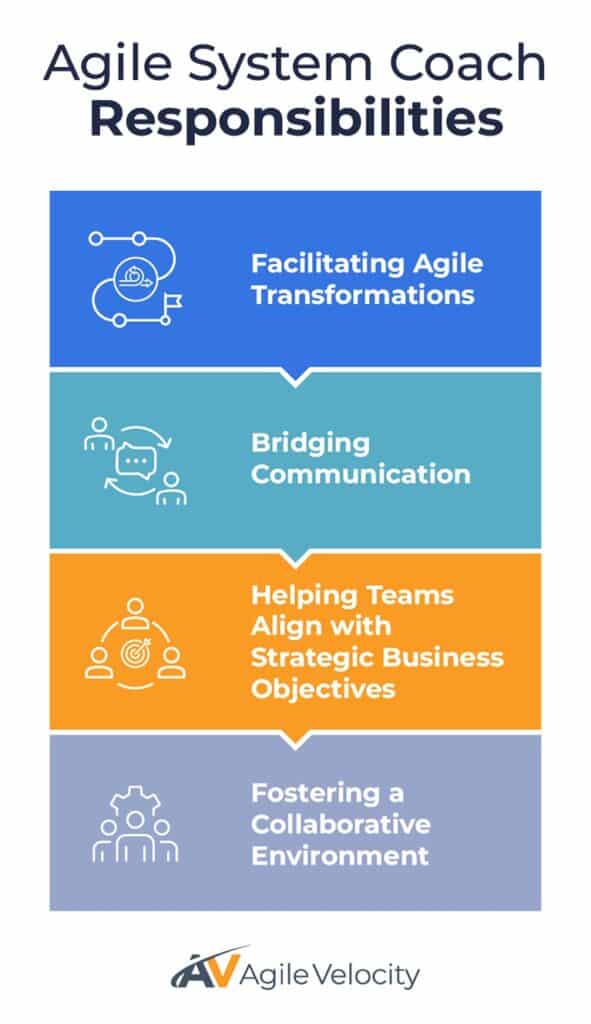Organizations today face relentless challenges, including rapid market evolution, shifting customer expectations, and disruptive technologies. To thrive, businesses need more than operational efficiency; they need organizational agility – the ability to adapt swiftly, respond effectively, and continuously improve.
Achieving true agility, however, is a complex undertaking that demands transformative changes in processes, structures, culture, and mindset. This is where the Agile System Coach becomes essential in driving Agile Transformations. Serving as the link between strategy and execution, the Agile System Coach empowers teams to align with business objectives, adapt swiftly to changes, and foster a culture of continuous improvement.
But who exactly is the Agile System Coach, and how do they differ from other coaching roles? How do they contribute to unlocking organizational agility, and why are they so vital in Agile Transformations? In this article, we’ll explore the essential functions of an Agile System Coach, examining their responsibilities, skills, and the significant impact they have on both teams and business outcomes.
An Agile System Coach not only guides teams through the transformation process but also ensures that the underlying principles of agility are deeply ingrained in the organizational culture.
Why is an Agile System Coach Essential?
Organizational agility has moved beyond being a trend—it’s a strategic necessity. Businesses aiming to stay competitive must adopt Agile practices that enable them to recognize environmental shifts and respond effectively. An Agile Transformation is often the chosen strategy to achieve this, involving the adoption of Agile Methodologies and practices across the organization.
At the core of this transformation is the Agile System Coach. Unlike traditional coaches who may focus solely on individual teams or high-level strategies, Agile System Coaches operate across all levels of the organization. They act as the crucial link connecting the strategic direction set by senior leadership with the daily execution by operational teams.
By ensuring that teams understand not only what they need to do but also why it’s important, the Agile System Coach helps align efforts across the organization. They facilitate communication, break down silos, and promote a shared understanding of goals. Essentially, they enable the organization to move cohesively towards its business outcomes, making the Agile System Coach a key driver in revolutionizing organizational agility.
Build High-Performing Teams
4 Core Responsibilities of an Agile System Coach
The Agile System Coach plays multiple roles, all aimed at fostering agility and driving successful Agile Transformations. Let’s explore their core responsibilities.


1) Facilitating Agile Transformations
Embarking on an Agile Transformation involves more than changing processes—it requires shifting mindsets and cultures. The Agile System Coach guides this journey, customizing Agile practices to fit the organization’s unique context. They help teams adopt frameworks like Scrum, Kanban, or the Scaled Agile Framework® (SAFe®), ensuring that Agile principles are understood and applied effectively.
Some of the activities involved in facilitating Agile Transformations include:
- Leading Development of Agile Roadmaps for Strategic Alignment – Agile System Coaches are integral to the planning phase, often developing and communicating the transformation roadmap. They act as a bridge between leadership and the operational teams, ensuring that everyone is informed about the direction and objectives of agile initiatives. This includes maintaining an improvement backlog and fostering guided continuous improvement processes by utilizing metrics and KPIs.
- Tracking Progression and Fostering Continuous Improvement – Agility focuses on continuous improvement. The Agile System Coach establishes metrics and tracking mechanisms to monitor progress. They facilitate regular retrospectives, encourage feedback, and help teams make necessary adjustments. By fostering a culture of reflection and learning, the Agile System Coach ensures that the organization not only adopts Agile practices but truly embodies the Agile mindset.
- Utilizing Agile Assessment Tools for Evaluating Current Capabilities – The Agile System Coach employs Agile assessment tools to evaluate the organization’s current capabilities. These tools provide insights into areas needing improvement and help in setting realistic goals for the transformation.
- Creating Actionable Roadmaps Aligned with Business Outcomes – Using the insights from assessments, the Agile System Coach develops actionable roadmaps that prioritize initiatives aligned with business outcomes. These roadmaps serve as a guide for teams, ensuring their efforts are directed towards achieving strategic goals.
2) Bridging Communication Between Leadership and Operational Teams
Effective communication is a cornerstone for the success of any organizational transformation, especially in Agile contexts. The Agile System Coach plays a pivotal role in ensuring seamless communication between leadership and operational teams. Here’s how they accomplish it:
Key Activities and Strategies
- Translating Vision into Actionable Plans
- Strategic Alignment: The Agile System Coach assists leadership in defining clear strategic objectives and ensures these objectives are transformed into actionable goals for operational teams.
- Actionable Roadmaps: By creating detailed, step-by-step roadmaps, the coach helps operational teams understand and implement the strategic vision in their daily activities.
- Facilitating Two-Way Communication
- Feedback Loops: Establishing structured feedback mechanisms such as regular meetings, Agile ceremonies, and digital tools that promote open dialogue between teams and leadership.
- Continuous Improvement: Leveraging regular retrospectives and check-ins to gather insights and feedback, which are shared with leadership for informed decision-making.
- Breaking Down Silos
- Cross-Functional Collaboration: Encouraging collaboration across different departments and teams to foster a unified approach toward achieving strategic goals.
- Shared Goals: Promoting a culture where teams are aware of the broader business objectives, encouraging them to work in alignment with the overall vision.
- Leveraging Agile Tools and Practices
- Agile Tools: Utilizing tools like Kanban boards, Agile project management software, and dashboards to visualize progress, identify roadblocks, and maintain transparency across the organization.
- Knowledge Sharing: Organizing workshops, training sessions, and Agile games to facilitate knowledge sharing and foster a culture of continuous learning.
- Building Trust and Empowerment
- Leadership Engagement: Encouraging leadership to engage regularly with teams, fostering trust and ensuring that leadership is visible and accessible.
- Empowerment: Enabling teams to make decisions within their scope, which not only quickens the decision-making process but also fosters a sense of ownership and accountability.
3) Helping Teams Align with Strategic Business Objectives
Teams frequently become engrossed in their daily tasks, losing sight of how their contributions feed into overarching organizational ambitions. The Agile System Coach addresses this disconnect by reinforcing the alignment between individual activities and larger business objectives, a crucial factor for sustained organizational success.
They facilitate workshops, strategy sessions, and regular briefings to convey the organization’s strategic vision and elucidate how each team member’s role is pivotal in achieving these goals. Through this, the coach fosters a culture of purpose-driven work, where employees understand not only what they’re doing but also why it matters to the organization’s trajectory and success.
Additionally, the Agile System Coach employs visual management tools, such as roadmaps and OKR (Objectives and Key Results) frameworks, to illustrate clear connections between specific tasks and strategic priorities. This approach nurtures a cohesive environment where transparency and clarity are integral to operations.
By aligning day-to-day activities with strategic business objectives, teams are not just executing tasks—they are contributing to meaningful milestones that drive the organization toward its vision. This alignment also strengthens team morale, as employees recognize their impact on the broader picture, leading to higher engagement levels and an increase in proactive problem-solving and innovation.
4) Fostering Collaboration for Shared Goals
A collaborative environment is the bedrock of organizational agility, allowing teams to work cohesively towards shared objectives, innovate more effectively, and adapt swiftly to change. The Agile System Coach plays a pivotal role in nurturing such an environment, using strategic tactics and fostering essential practices. Here’s how the Agile System Coach can enhance collaboration for achieving shared goals:
Creating a Culture of Collaboration
- Encouraging Cross-Functional Teams: Integrate various skill sets and perspectives by forming cross-functional teams. This approach not only broadens the scope of problem-solving but also enhances team learning and innovation.
- Open Communication Channels: The Agile System Coach facilitates the opening of communication lines, ensuring information flows freely across the organization. This transparency helps in reducing misunderstandings and fosters trust.
Implementing Collaborative Tools and Practices
- Digital Collaboration Platforms: Promote the usage of tools like Slack, Microsoft Teams, and Asana, which offer digital spaces for team communication, project management, and document sharing. These tools enable real-time updates and foster collaborative teamwork even in remote setups.
- Agile Practices: Incorporate Agile ceremonies like stand-ups, retrospectives, and planning sessions to maintain regular team touchpoints, enhancing interaction and feedback loops essential for continuous improvement.
Promoting Shared Values and Vision
- Aligning Values: Encourage teams to align their daily activities with organizational values and mission. This shared understanding unites team members in pursuit of the same goals, enhancing commitment and teamwork.
- Goal Setting and Recognition: Utilize frameworks like OKRs (Objectives and Key Results) to set clear, measurable goals that support organizational objectives. Recognizing achievements related to shared goals strengthens team cohesion.
Conflict Resolution and Mediating Disputes
- Training in Conflict Resolution: Equip teams with conflict resolution skills through workshops and training sessions. This training helps teams to navigate disagreements constructively, turning conflicts into opportunities for better understanding and innovation.
- Mediation by Agile System Coach: Act as a neutral mediator when conflicts arise within or between teams. The coach can facilitate discussions that lead to consensus and mutual respect.
Encouraging Innovation and Rapid Experimentation
- Safe-to-Fail Environment: Foster a culture where experimentation is encouraged, and failures are viewed as learning opportunities. This mindset allows teams to test new ideas without fear, thus promoting innovation.
- Innovation Workshops: Conduct regular ideation sessions and hackathons to stimulate creativity and innovation across teams.
By implementing these strategies, the Agile System Coach ensures that teams not only achieve their immediate targets but also contribute to the organization’s strategic vision through enhanced collaboration and shared goal attainment. This transformative environment fosters a shared sense of purpose, increasing engagement and driving the organization towards long-term success.
Essential Skills and Competencies to Look for in an Agile System Coach

Navigating an Agile Transformation requires a diverse set of skills and competencies. The Agile System Coach must be equipped with the following:
In-Depth Understanding of Agile Practices and Principles
An Agile System Coach must be well-versed in Agile principles and frameworks. This expertise allows them to guide teams in selecting practices that best fit their context and to adapt these practices as needed.
Strong Communication, Coaching, and Facilitation Skills
Effective communication is at the heart of the Agile System Coach’s role. They must convey complex ideas clearly, listen actively, and facilitate productive discussions. Their coaching skills enable them to mentor individuals and teams, fostering growth and development.
Ability to Translate Strategic Objectives into Actionable Tasks
Strategic objectives can often be abstract or high-level. The Agile System Coach excels at breaking these down into actionable tasks that teams can execute. This involves critical thinking, planning, and a thorough understanding of both the strategic and operational aspects of the organization.
Expertise in Managing Organizational Change and Cultural Adaptation
Transitioning to an Agile way of working involves significant change. The Agile System Coach must be skilled in change management, helping the organization navigate resistance and promoting a culture that embraces continuous improvement and adaptability.
Strategic Thinking and Business Acumen
The Agile System Coach aligns Agile initiatives with business objectives and understands market dynamics. This strategic insight ensures that Agile practices contribute directly to the organization’s success.
Get Your Boss On Board
The Impact Agile System Coaches Have on Teams and Business Outcomes
The influence of the Agile System Coach extends beyond processes and practices—they significantly impact teams and the achievement of business outcomes.
Enhancing Team Dynamics and Performance Metrics


By coaching teams on Agile principles and facilitating collaboration, the Agile System Coach enhances team dynamics. Teams become more self-organizing, empowered to make decisions, and agile in their approach.
This leads to tangible improvements in performance metrics such as:
- Increased Productivity: Agile practices have been shown to significantly enhance team productivity, with Agile teams being about 25% more productive than their non-Agile counterparts.
- Higher Quality: A focus on continuous improvement results in fewer defects and higher-quality deliverables.
- Better Morale: Empowered teams are more engaged and motivated.
Improving Alignment with Key Business Outcomes
When teams understand how their work connects to strategic objectives, they become more focused on delivering business outcomes. The Agile System Coach ensures this alignment, leading to:
- Greater Customer Satisfaction: By prioritizing value delivery, teams better meet customer needs.
- Faster Time-to-Market: Agile practices enable quicker delivery of products and features. Agile Transformations can lead to a reduction in development time.
- Increased Innovation: Collaborative environments foster creativity and the generation of new ideas.
Contributing to the Organization’s Agility and Transformation Success
The ultimate goal of the Agile System Coach is to enhance the organization’s overall agility. Their efforts lead to:
- Adaptability: The organization becomes more capable of responding to market changes.
- Sustainability: Agile practices become embedded, resulting in lasting improvements.
- Competitive Advantage: Agility allows the organization to stay ahead of competitors.
Impact on Organizational Agility
- Enhanced Alignment: By bridging the gap between strategy and execution, the Agile System Coach ensures that teams are not only working productively but also working towards the right objectives that support the organizational mission.
- Improved Responsiveness: With efficient communication channels, organizations can respond more swiftly to market changes and internal challenges, staying ahead in competitive environments.
- Fostering an Agile Mindset: Ongoing communication across levels helps in embedding Agile principles, ensuring that these are not just practiced but also are ingrained in the organizational culture.
- Increased Employee Engagement: Transparent and regular communication boosts morale and engagement as employees feel heard and valued in the transformation journey.
The Agile System Coach not only enhances communication but also ensures that the transformation effort is cohesive, strategic, and impactful, driving both team effectiveness and business success.
Realize True Competitive Advantage with the Agile System Coach

Organizational agility isn’t merely a goal—it’s an ongoing journey that requires guidance, alignment, and continuous effort. An Agile System Coach is essential in revolutionizing this agility. By connecting strategy to execution, the Agile System Coach ensures that teams are not only performing tasks correctly but also focusing on the right priorities.
Their role in facilitating Agile Transformations, enhancing team dynamics, and driving business outcomes is invaluable. They help create an environment where teams are empowered, aligned with business objectives, and capable of adapting to change swiftly.
Embracing the Agile coaching mindset can lead to transformative results. It’s not just about adopting new processes but about cultivating a culture of continuous improvement, collaboration, and responsiveness. In today’s market, organizations that unlock this agility are the ones poised for long-term success.
To learn more about how your organization can benefit from the guidance of an Agile System Coach, explore Agile Velocity’s solutions for improving organizational agility.



